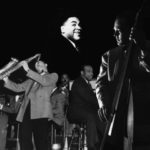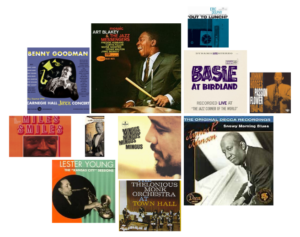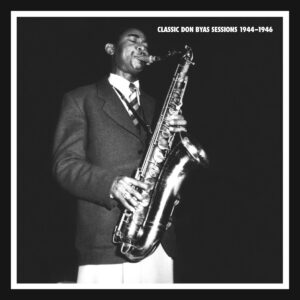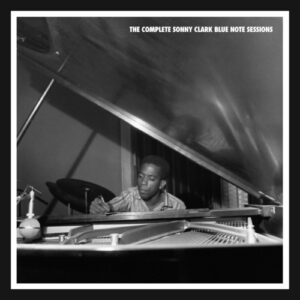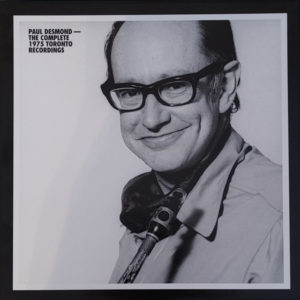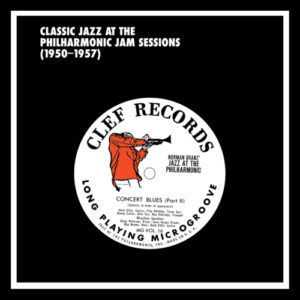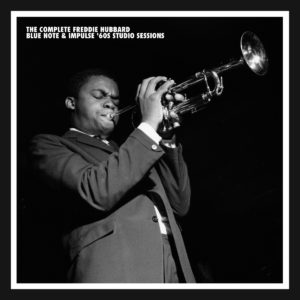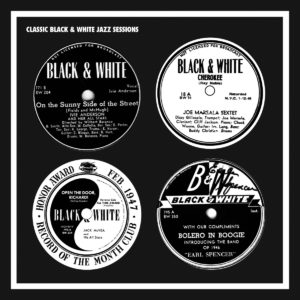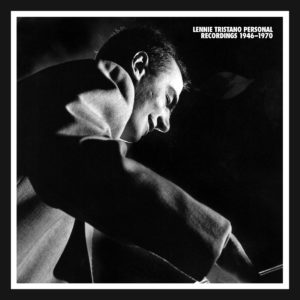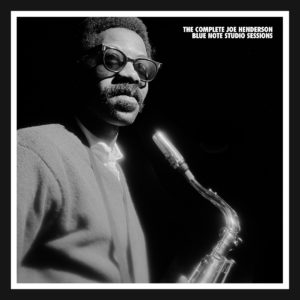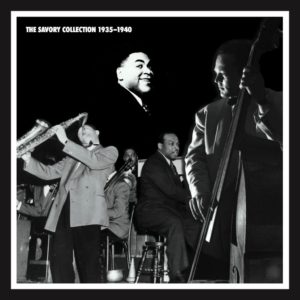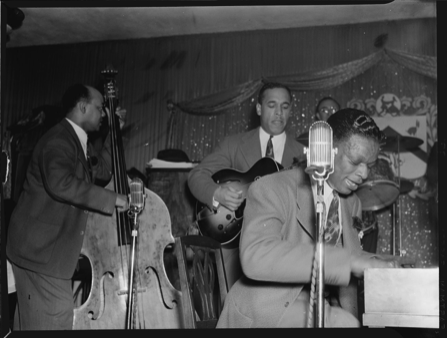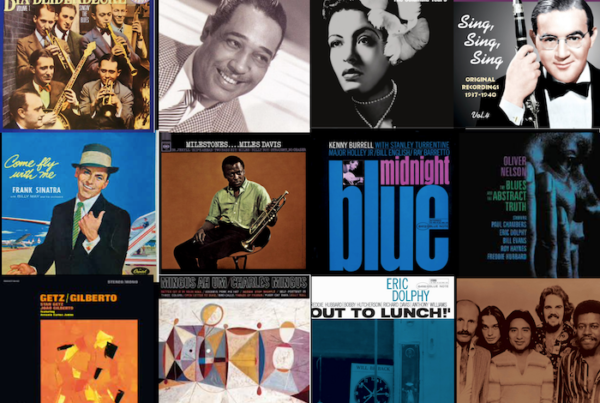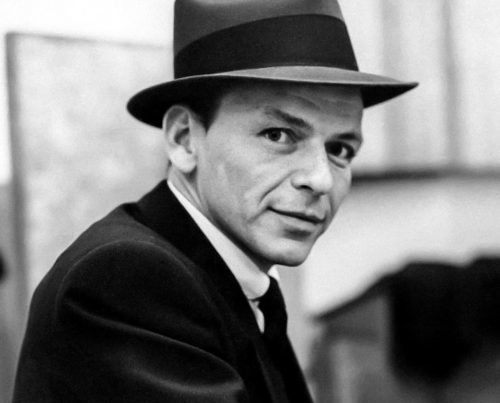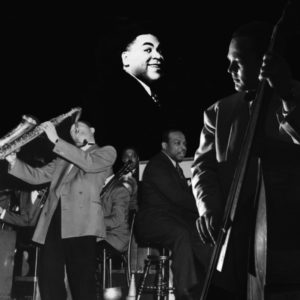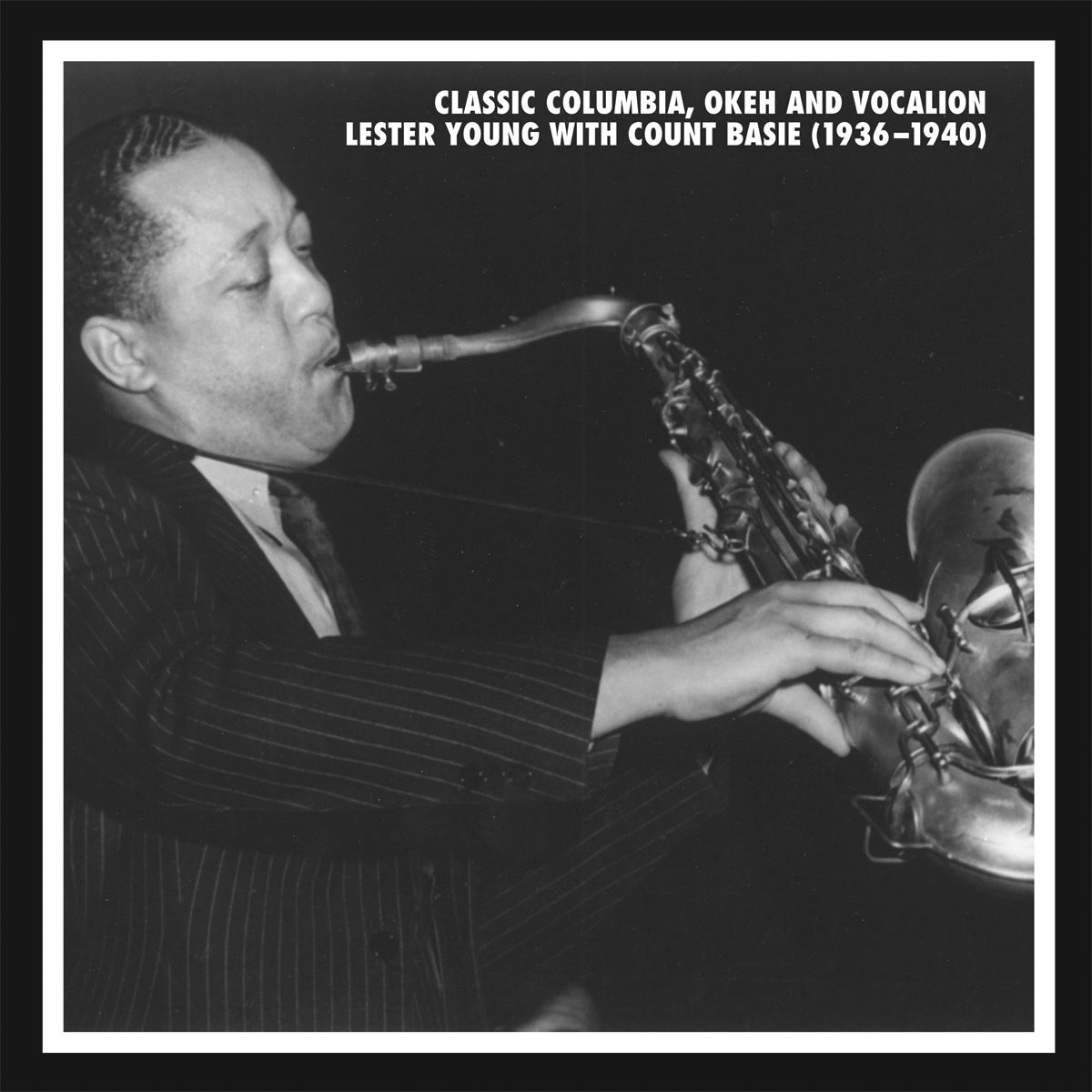
Classic Columbia, OKeh, and Vocalion Lester Young with Count Basie 1936-1940
(Set is out-of-print)
By: Alan Goodman
“Irrespective of tempo, his melodic invention was always strange and haunting. On a jump number, he would impose a weird mood; a ballad was transformed into a nostalgic song, searching and mysterious.” – Stanley Dance
A set whose contents rank among the
most influential recordings in history.
It was an era when the music was in transition; a time when musicians were achieving new milestones of personal expression; a point in his career when Count Basie, with Lester Young and others beside him, was establishing his credentials as one of the leading band leaders of the swing era; and the moment when Lester Young was creating a completely new approach to the tenor saxophone. Without reservation, we can assure you these are masterpieces.
The suppleness of the Basie, Jones and Page rhythm section and how conducive it was for electrifying soloists has been well-documented. But you can’t overstate the effect on Lester Young. Other musicians – great ones – would build solos that seemed utterly brilliant for their organization and improvised cleverness. Young’s seemed brilliant for arriving places utterly unexpected. For decades, saxophonists have sought to match his level of carefree, confident command.
Years of Drifting Until He Met His Match
Lester Young came from a family of professional musicians and toured as a child with his father’s band, but he was already on his own by the age of 18. He moved from band to band, including stints with Art Bronson, Walter Page (the bassist who would eventually team with Basie), King Oliver, Eddie Barefield, and in Kansas City with the Bennie Moten-George E. Lee Band.
When Fletcher Henderson’s touring organization hit town, Young came out of the audience to replace Coleman Hawkins one fateful night when Hawkins was late – an event which set off an infamous competition between the two great tenor saxophonists. Hearing about Young’s ability, the next time Henderson’s crew rolled into town Hawkins cornered Lester for a throw down. By all accounts, when the session ended well past sun-up, Hawkins, sweating and stripped to his T-shirt, had met his match.
Young briefly worked with Basie in 1934 before moving to New York to replace Hawkins in the Henderson band. His fellow band members tormented Young through some tough months, which were eased a bit by his new friendship with Billie Holiday and the beginning of their musical relationship. Unable to take the abuse on the bandstand, Young left and began drifting again in bands between Kansas City and Minneapolis. Then, one night, he heard Basie on the radio. Young went to the telegraph office to send a message to his old boss, asking for his job back.
You hear it on this collection from the opening notes of “Shoe Shine Boy,” the tune that contains Lester Young’s first recorded solo. While schooled in the stride style, Basie largely eschews what would typically be played by the left hand in favor of something sparser, while running tip-toe through the keys with his right. He could concentrate on higher, lighter tones because of the support Walter Page provides, fleetly walking through the bass strings.
Jo Jones also concentrates on the top tones, putting rhythm into the cymbals that beforehand had been played on the bass drum. Add to all this lightness the solos of Lester Young, who plays in stark contrast to the commanding honk of a Hawkins and who seems always at ease, even when working his way through the hardest driving tunes.
Basie, who always seems to be measuring out his notes with witty reserve, gives Young license and context for his own coy inventions. He could blow chorus after chorus (producer John Hammond recounted a jam session when Young played 83 straight), and his solos will disappoint a listener’s efforts to find cliches.
Just as a figure sounds familiar, he’ll hang from a note until the moment he decides to casually release his fingertips. He’ll add a little swivel to the middle of a run, like a dancer who suddenly finds her hips swinging – a delightful, private reverie. He’ll saw off a succession of notes and tie them with a string, just as an after-thought. Everything he plays is unimaginable, until he plays it. And he’ll do it endlessly, while still appearing to be holding something in reserve.
Young was fully capable of achieving a section sound on ensemble pieces, but as a soloist he chose to stand apart from his fellow musicians. It was a stance that helped make him hard to cut. His solos introduced concepts that were revolutionary for their melodic content, their rhythmic complexities, and the very way he articulated the notes, often creating sounds no one had heard before.
Classic Recordings And New Discoveries
Our 4-CD set includes 84 tracks, beginning with Basie’s and Young’s first session together under the the name “Jones-Smith Inc.” The collection is notable as well for including along with all previously-known gems on the Columbia labels, the results of our research in the vaults: almost a dozen of alternate tracks never heard before. Also included is the legendary session from the Benny Goodman Septet with Count Basie.
Sidemen in addition to Page and Jones include Buck Clayton, Charlie Christian, Freddie Green, Jimmy Rushing, Harry Edison, Vic Dickenson, and Tab Smith.
You’ll hear many tunes from the Basie book now considered classics, such as “Oh, Lady Be Good “Lonesome Miss Pretty,” “Dickie’s Dream,” Young’s signature tune “Lester Leaps In,” “Easy Does It,” and more. These are the definitive versions and the very tunes emulated by generations of saxophonists who followed Lester Young’s lead.
The Mosaic booklet includes rare photographs from the period that are rarely seen including six photos from the Goodman session. Immersing yourself in Loren Schoenberg’s passionate and well-documented liner notes while listening to the brilliant remastering production by Malcolm Addey from the original source material is a jazz lover’s joy.
As a collection, there could be no finer testimony for how well-suited Young and Basie were for each other.
Classic Columbia, OKeh, and Vocalion Lester Young with Count Basie 1936-1940
Discography
For the purposes of this discography, only the first issue number of each matrix is listed. All are American releases unless noted (Sd) for Sweden. To the best of our knowledge, the discography is in the order in which the tunes were recorded. However, the CDs contained in this box set are presented with the master take first and then any alternates at the conclusion of the disc.
The following arrangers are abbreviated for this set: Count Basie (CB), Buck Clayton (BC), Andy Gibson (AG), Elton Hill (EH), Skippy Martin (SM), Jimmy Mundy (JM), Don Redman (DR), Tab Smith (TS), Henri Woode (HW).
________________________________________________________________________
(A) JONES-SMITH INC
Carl “Tatti” Smith (tp), Lester Young (ts), Count Basie (p), Walter Page (b), Jo Jones (d), Jimmy Rushing (vcl).
Chicago, November 9, 1936
C 1657-2 Shoe Shine Boy Tax (Sd) m-8000 (LP)
C 1657-1 Shoe Shine Boy Voc 3441
C 1658-1 Evenin’ (JR-vcl) –
C 1659-1 Boogie Woogie (JR-vcl) Voc 3459
C 1660-1 Oh, Lady Be Good –
Note: Although the Vocalion ledgers and cards state the session above took place on October 9, 1936, this seems to be a clerical error. All accounts from the musicians, John Hammond and adjacent matrix numbers, confirm that November 9th is the correct date.
The initial artist credit listed in the ledgers for this session was “Jones-Smith Inc. of Kansas City”.
________________________________________________________________________
(B) BASIE’S BAD BOYS
Buck Clayton, Shad Collins (tp), Dan Minor (tb) -1, Lester Young (cl, ts), Count Basie (p, org), Freddie Green (g), Walter Page (b), Jo Jones (d), Jimmy Rushing (vcl).
Chicago, February 13, 1939
24510-1 I Ain’t Got Nobody Col G 31224 (LP)
24511-1 Goin’ To Chicago (JR-vcl) -1 –
24512-1 Live And Love Tonight –
24513-1 Love Me Or Leave Me –
Note: The CD reissuecount basie – america’s #1 band incorrectly lists this session as being first issued on CBS 66101 as a 10″ LP in 1952. CBS 66101 is actually a set of 10 LPs.
Some discographies list Dicky Wells as the trombonist on Goin’ To Chicago. However, the Vocalion ledgers show his name was erased (but still somewhat visable) and Dan Minor’s name penciled in. ________________________________________________________________________
(C) COUNT BASIE AND HIS ORCHESTRA: Buck Clayton, Shad Collins, Harry Edison, Ed Lewis (tp), Dan Minor, Benny Morton, Dicky Wells (tb), Earle Warren (as), Buddy Tate, Lester Young (ts), Jack Washington (as, bari), Count Basie (p), Freddie Green (g), Walter Page (b), Jo Jones (d), Helen Humes, Jimmy Rushing (vcl).
NYC, March 19, 1939
W24238-2 What Goes Up Must Come Down (JR-vcl) Col JG 34840 (LP)
W24238-1 What Goes Up Must Come Down (JR-vcl) Voc 4734
W24242-2 Taxi War Dance Col JG 34840 (LP)
W24242-1 Taxi War Dance Voc 4748
________________________________________________________________________
(D) COUNT BASIE AND HIS ORCHESTRA: Same as (C).
NYC, March 20, 1939
W24243-2 Don’t Worry ‘Bout Me (HH-vcl) (AG-arr) Col JG 34840 (LP)
W24243-1 Don’t Worry ‘Bout Me (HH-vcl) (AG-arr) Voc 4734
________________________________________________________________________
(E) COUNT BASIE AND HIS ORCHESTRA: Same as (C).
NYC, April 5, 1939
W24337-A And The Angels Sing (HH-vcl) Voc 4784
W24338-A If I Didn’t Care (HH-vcl) –
W24339-A Twelfth Street Rag Voc 4886
W24340-A Miss Thing (Pt.1) (SM-arr) Voc 4860
W24341-A Miss Thing (Pt.2) (SM-arr) –
Note: The Vocalion ledgers state that miss thing (both parts) were “to be rerecorded – con’t 4-17-39”. The metal parts also show the April 5th date as being crossed out and 4/17/39 entered instead. However, the Basie band was at the Royal Theater in Baltimore during April 14th through the 20th. Some discographies list Jimmy Mundy as the arranger for miss thing.
________________________________________________________________________
(F) COUNT BASIE AND HIS ORCHESTRA: Same as (C).
Chicago, May 19, 1939
WC 2594-A Lonesome Miss Pretty (BC-arr) Col CL 6079 (LP)
WC 2595-A Bolero At The Savoy (HH-vcl) (JM-arr) Tax (Sd) m-8000 (LP)
WC 2597-A Pound Cake (CB-arr) Voc 5085
Note: Each of the titles from this session were initially issued (and frequently re-issued) using the “C” takes, which are dubs of the “A” takes. For this set we used the “A” takes. ________________________________________________________________________
(G) COUNT BASIE AND HIS ORCHESTRA: Same as (C).
Chicago, June 24, 1939
WC 2632-B You Can Count On Me (HH-vcl) Col JG 34840 (LP)
WC 2632-A You Can Count On Me (HH-vcl) Voc 4967
________________________________________________________________________
(H) GLENN HARDMAN AND HIS HAMMOND FIVE: Lee Castle (tp), Lester Young (cl, ts), Glenn Hardman (org), Freddie Green (g), Jo Jones (d).
Chicago, June 26, 1939
WC 2636-A China Boy Col 35341
WC 2637-B Exactly Like You Col JG 34840 (LP)
WC 2637-A Exactly Like You Voc 4971
WC 2638-A On The Sunny Side Of The Street Col 35341
WC 2639-A Upright Organ Blues Col 35263
WC 2640-A Who ? Voc 4971
WC 2641-A Jazz Me Blues Col 35263
Note: This session can be found on Disc IV of this set.
________________________________________________________________________
(I) COUNT BASIE AND HIS ORCHESTRA: Same as (C).
NYC, August 4, 1939
W 24979-A Song Of The Islands (poss. BC-arr) Voc 5169
W 24981-A Clap Hands, Here Comes Charlie (SM-arr) Voc 5085
________________________________________________________________________
(J) COUNT BASIE KANSAS CITY SEVEN: Buck Clayton (tp), Dicky Wells (tb), Lester Young (ts), Count Basie (p), Freddie Green (g), Walter Page (b), Jo Jones (d).
NYC, September 5, 1939
W 25296-3 Dickie’s Dream Tax (Sd) m-8000 (LP)
W 25296-2 (BD) Dickie’s Dream –
W 25296-1 Dickie’s Dream Voc 5118
W 25297-2 Lester Leaps In Col D-77 (LP)
W 25297-1 Lester Leaps In Voc 5118
Note: The original title of Dickie’s Dream, according to the Vocalion ledgers, was to be conversation piece. Some LP issues list -4 for Dickie’s Dream, however, this is not a different take but a copy of the master take (-1). Some discographies also list -4 as the 78 master take.
________________________________________________________________________
(K) COUNT BASIE AND HIS ORCHESTRA: Same as (C).
L.A., November 6, 1939
WCO 26276-A (-2) The Apple Jump (AG-arr) OK 5862
(WCO 26277) -2 I Left My Baby (JR-vcl) (AG-arr) previously unissued
(WCO 26277) -6 (BD) I Left My Baby (JR-vcl) (AG-arr) –
WCO 26277-A (-7) I Left My Baby (JR-vcl) (AG-arr) Col 35321
(WCO 26278) -1 Riff Interlude (CB-arr) previously unissued
(WCO 26278) -2 Riff Interlude (CB-arr) –
(WCO 26278) -3 (BD) Riff Interlude (CB-arr) –
(WCO 26278) -4 Riff Interlude (CB-arr) –
WCO 26278-A (-5) Riff Interlude (CB-arr) Col 35321
Note: This session and the next were transferred from newly found lacquer discs which bear the prefix HH in addition to an individual disc number (HH 2406, HH 2407, etc.). No mention is made of the regular WCO matrix number on these lacquers and each individual take is listed numerically rather than alphabetically as is found on the issued 78.
The first attempts (-1) of the Apple Jump and I Left My Baby are both short breakdowns and are not included here. The sixth take of I Left My Baby is another breakdown and can be heard right after the alternate take -2 at the end of Disc II. The lacquer disc or discs that have takes -3, -4 and -5 of I Left My Baby are no longer in the physical possession of Sony and are feared lost or were destroyed.
The ledgers claim that this and the next session were “to be rerecorded – 11-20-39″ and even some of the dates on the metal parts (stating 11/7) are crossed out as well. However, November 7th is the correct date as the Basie band were traveling on one-nighters at this time and on the 20th were in Monroe, La.
Epic LN 3168 (LP), Let’s Go To Prez, states that an unreleased take was used for riff interlude. However, -A is the take that is used.
________________________________________________________________________
(L) COUNT BASIE AND HIS ORCHESTRA: Same as (C).
L.A., November 7, 1939
(WCO 26280) -1 (BD) Between The Devil And The
Deep Blue Sea (HH-vcl) (AG-arr) previously unissued
(WCO 26280) -2 (BD) Between The Devil
And The Deep Blue Sea (AG-arr) –
(WCO 26280) -3 Between The Devil And The
Deep Blue Sea (HH-vcl) (AG-arr) –
WCO 26280-A (-4) Between The Devil And The
Deep Blue Sea (HH-vcl) (AG-arr) Col 35357
(WCO 26280) -5 Between The Devil And The
Deep Blue Sea (HH-vcl) (AG-arr) previously unissued
(WCO 26281) -5 (BD) Ham ‘N’ Eggs (CB-arr) –
(WCO 26281) -6 Ham ‘N’ Eggs (CB-arr) –
WCO 26281-A (-7) Ham ‘N’ Eggs (CB-arr) Col 35357
(WCO 26282) -1 Hollywood Jump (AG-arr) previously unissued
WCO 26282-A (-2) Hollywood Jump (AG-arr) Col 35338
Note: See above for details on the matrix system for this session. The two breakdowns on Between The Devil and The Deep Blue Sea can be heard together on track 11 of Disc III.
The disc or discs that have takes -1 through -4 of Ham ‘n’ Eggs are no longer in the physical possession of Sony and are feared lost or were destroyed. Epic LN 3168 (LP), Let’s Go To Prez, states that an unreleased take was used for Ham ‘n’ Eggs. However, -A (-2) is the take that is used.
________________________________________________________________________
(M) COUNT BASIE AND HIS ORCHESTRA: Buck Clayton, Harry Edison, Al Killian, Ed Lewis (tp), Vic Dickenson, Dan Minor, Dicky Wells (tb), Earle Warren (as), Buddy Tate, Lester Young (ts), Jack Washington (as, bari), Count Basie (p), Freddie Green (g), Walter Page (b), Jo Jones (d), Helen Humes, Jimmy Rushing (vcl).
NYC, March 19, 1940
WCO 26655-A I Never Knew (AG-arr) Col 35521
WCO 26656-A Tickle-Toe (AG-arr) –
WCO 26657-B Let’s Make Hay While
The Moon Shines (EH-arr) Col G 31224 (LP)
WCO 26657-A Let’s Make Hay While
The Moon Shines (EH-arr) Col 35500
WCO 26658-B Louisiana (AG-arr) Epic LN 3168 (LP)
WCO 26658-A Louisiana (AG-arr) Col 35448
Note: Epic LN 3168 (LP), Let’s Go To Prez, states that an unreleased take was used for Tickle Toe. However, -A is the take that is used. The same Epic LP does not list louisiana as an unreleased alternate. Some discographies claim Tadd Dameron as the arranger on Louisiana.
________________________________________________________________________
(N) COUNT BASIE AND HIS ORCHESTRA: Same as (M).
NYC, March 20, 1940
CO 26659-A Easy Does It (JM-arr) Col 35448
CO 26660-B Let Me See (AG-arr) Col C2 34849 (LP)
CO 26660-A Let Me See (AG-arr) OK 6330
Note: According to the metal part, easy does it was originally titled music easy.
________________________________________________________________________
(O) COUNT BASIE AND HIS ORCHESTRA: Same as (M) except add Tab Smith (as, arr).
NYC, May 31, 1940
W 26870-B Blow Top (TS-arr) OK 5629
W 26870-A Blow Top (TS-arr) Epic LN 3168 (LP)
Note: Epic LN 3168 (LP), let’s go to prez, does not list blow top as an unreleased alternate.
________________________________________________________________________
(P) COUNT BASIE AND HIS ORCHESTRA: Same as (M).
Chicago, August 8, 1940
WC 3254-A Evenin’ (JR-vcl) OK 5732
WC 3255-A The World Is Mad (Pt.1) (AG-arr) OK 5816
WC 3256-A The World Is Mad (Pt.2) (AG-arr) –
________________________________________________________________________
(Q) BENNY GOODMAN SEPTET: Buck Clayton (tp), Lester Young (ts), Benny Goodman (cl), Count Basie (p), Charlie Christian (el-g), Freddie Green (g), Walter Page (b), Jo Jones (d).
NYC, October 28, 1940
-0- Ad Lib Blues Jazz Archives 6 (LP)
-0- Wholly Cats –
-0- Charlie’s Dream –
-0- I Never Knew –
-0- Lester’s Dream –
________________________________________________________________________
(R) COUNT BASIE AND HIS ORCHESTRA: Same as (M).
NYC, October 30, 1940
CO 29008-3 What’s Your Number? (BC-arr) Col C2 34849 (LP)
CO 29008-2 What’s Your Number? (BC-arr) Tax (Sd) m-8027 (LP)
CO 29008-1 What’s Your Number? (BC-arr) OK 5897
Note: According to the OKeh ledgers this was originally titled Swing Low, Sweet Rhythm.
Columbia C2 34849 (LP) incorrectly lists -2 as -3 and -3 as -2.
________________________________________________________________________
(S) COUNT BASIE AND HIS ORCHESTRA: Same as (M).
NYC, November 19, 1940
CO 29087-2 Five O’Clock Whistle (DR-arr) Col C2 34849 (LP)
CO 29087-BD Five O’Clock Whistle (DR-arr) –
CO 29087-1 Five O’Clock Whistle (DR-arr) OK 5922
CO 29090-2 Broadway (HW-arr) Col C2 34849 (LP)
CO 29090-1 Broadway (HW-arr) OK 6095
Note: Some discographies and LP reissues (including Columbia C2 34849) incorrectly list the master take of Five O’Clock Whistle as -3 on OKeh 5922 and the alternate as -1. Columbia C2 34849 also lists -2 as -1.
________________________________________________________________________
ALBUM INDEX:
10″ LPs:
Columbia CL 6079 Count Basie – Count Basie Dance Parade
12” LPs:
Columbia Record Club D-77 Various Artists – The Sound Of Jazz Genius
Columbia G 31224 Count Basie – Super Chief
Columbia JG 34840 The Lester Young Story, Vol.3 – Enter The Count
Columbia C2 34849 The Lester Young Story, Vol.5 – Evening Of A
Basie-ite
Epic LN 3168 Lester Young / Count Basie – Let’s Go To Prez
Jazz Archives 6 Charlie Christian & Lester Young – Together 1940
Tax (Sweden) m-8000 Lester Young – The Alternative Lester
Tax (Sweden) m-8027 Count Basie – The Jitters
Original sessions supervised by: John Hammond
Produced for release by: Scott Wenzel
Executive Producer: Michael Cuscuna
Disc transfers: Michael Brooks, Matt Cavaluzzo, Andreas Meyer, Mark Wilder
Mastered using 24-bit technology by Malcolm Addey
Vault research: Michael Brooks, Anthony Fountain, Scott Wenzel
Special thanks: Michael Brooks, Tom Doerr, The Institute of Jazz Studies, Robin Manning, Dan Morgenstern, Michael Panico, Phil Schaap and Tom Tierney.
The master take of What Goes Up Must Come Down provided by Scott Wenzel. The remainder of the sources came from either metal parts or lacquer discs. The unissued material came from lacquers that were recently located by Michael Brooks at Sony Studios.
This compilation (p) 2008 SONY BMG MUSIC ENTERTAINMENT /Manufactured by SONY BMG MUSIC ENTERTAINMENT, 550 Madison Avenue, New York, NY 10022-3211/WARNING All Rights Reserved. Unauthorized duplication is a violation of applicable laws.
© 2008 Mosaic Records L.L.C., 35 Melrose Place, Stamford, CT 06902. All rights reserved.
Phone: 203-327-7111/Fax 203-323-3526/ Website: www.mosaicrecords.com.
PRODUCER’S NOTE:
The focus of this set was to present all of Lester Young’s solo efforts under Count Basie’s leadership for the Columbia family of labels. In addition, we have included the Glenn Hardman and his Hammond Five date plus a Benny Goodman small group session that went unreleased until 1973.
In addition to the original file cards and ledgers, the following sources were used for this discography: Lestorian Notes – A Discography & Biography of Lester Young by Piet Koster and Harm Moback (Micrography Pub.), The Jazz Discography by Tom Lord (Cadence Jazz Books), Jazz Records 1897-1942 Sixth Edition by Brian Rust (Storyville) and Count Basie: A Bio-Discography by Chris Sheridan (Greenwood Press).
Scott Wenzel

